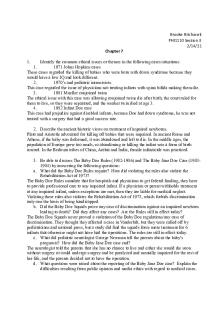PHI1110 CH7 PDF

| Title | PHI1110 CH7 |
|---|---|
| Author | Brooke Brichacek |
| Course | Ethical Issues in Health Care |
| Institution | Wayne State University |
| Pages | 3 |
| File Size | 79.4 KB |
| File Type | |
| Total Downloads | 40 |
| Total Views | 157 |
Summary
Chapter 7 homework...
Description
Brooke Brichacek PHI1110 Section 3 2/14/21 Chapter 7 1.
Identify the common ethical issues or themes in the following cases/situations: 1. 1971 Johns Hopkins cases These cases regarded the killing of babies who were born with down syndrome because they would have a low IQ and look different. 2. 1970’s and pediatric intensivists. This case regarded the issue of physicians not treating infants with spina bifida making them die. 3. 1981 Mueller conjoined twins The ethical issue with this case was allowing conjoined twins die after birth; the court ruled for them to live, so they were separated, and the weaker twin died at age 3. 4. 1982 Infant Doe case This case had prejudice against disabled infants, because Doe had down syndrome, he was not treated with a surgery that had a good success rate. 2. Describe the ancient/historic views on treatment of impaired newborns. Plato and Aristotle advocated for killing off babies that were impaired. In ancient Rome and Athens, if the baby was deformed, it was abandoned and left to die. In the middle ages, the population of Europe grew too much, so abandoning or killing the infant was a form of birth control. In the Bedouin tribes of China, Arabia and India, female infanticide was practiced. 3. Be able to discuss The Baby Doe Rules (1982-1986) and The Baby Jane Doe Case (19831984) by answering the following questions: a. What did the Baby Doe Rules require? How did violating the rules also violate the Rehabilitation Act of 1973? The Baby Doe Rules mandate that for hospitals and physicians to get federal funding, they have to provide professional care to any impaired infant. If a physician or parent withholds treatment ot any impaired infant, unless exceptions are met, then they are liable for medical neglect. Violating these rules also violates the Rehabilitation Act of 1973, which forbids discrimination only one the basis of being handicapped. b. Did the Baby Doe Squads prove any case of discrimination against an impaired newborn leading to death? Did they affect any cases? Are the Rules still in effect today? The Baby Doe Squads never proved a violation of the Baby Doe regulations/any case of discrimination. They thought they affected a case in Vanderbilt, but they were called off by pediatricians and national press, but a study did find the squads force more treatment for 6 infants that otherwise might not have had the operations. The rules are still in effect today. c. What did pediatric neurologist George Newman tell the parents about the baby's prognosis? How did the Baby Jane Doe case end? The neurologist told the parents that she has no chance to live and either she would die soon without surgery or could undergo surgery and be paralyzed and mentally impaired for the rest of her life, and the parents decided not to have the operation. d. What questions were raised about the reporting of the Baby Jane Doe case? Explain the difficulties resulting from public opinion and media ethics with regard to medical cases.
The media favored the parents, and it was impossible for any reporter to present another side in this time. The physicians would not talk to reporters about the controversial case, and the public could only find out what was happening in court. All the major media accepted George’s negative prognosis as a fact, and they should have looked at the patient chart because the doctor’s chart contradicted from what he told the parents. The public never read about the two real sides of the medical controversy. 4. What are 2 reasons given as to why parents may be reluctant to raise a profoundly disabled child? Being reluctant to raise a disabled child may not always be for selfish reasons; it may just be realistic. The parents may not want to give up their job and they may not want their child to outlive them where no one will be there to take care of them. 5. The 5 suggestions that are proposed for the beginning of personhood in this chapter are potential-for-relationships, the gradient view, the cognitive criterion, when they have a self-concept, and when they can use language. Describe the 3 we have not yet discussed for credit. Potential-for-relationship standard: the impaired newborn cannot be identified as a person until they have lived. It is hard to predict the potential for the relationship at birth and it is dependent on the parent’s attitude. Self-concept: infants are not persons until they develop this trait, which is around age 2 Use language: being able to speak and listen to language 6. How have people with Down syndrome and spina bifida experienced prejudice in the past, especially about their IQ? Babies whose health problems are less serious should be treated, and babies with the most serious conditions should able to let die. In the 1950s it was rare for a down syndrome baby to live long, and so death was a normal expected outcome. The children who survived were in institutions where they were not educated and so their IQs were even lower. a. How does Lorber attempt to predict future quality of life in order to decide when to forgo treatment of impaired newborns? Lorber made a criterion to predict at birth which lives were worth saving, which was adopted. b. What is the significance of exploring degrees of defect? To explore the degree of defect physicians used IQ to describe the scale of intelligence associated with happiness. Down syndrome patients whose IQ that was between a 50-70 was assumed to be unappy. 7. What is the Child Abuse Prevention and Treatment Act of 1974? The Child Abuse Prevention and Treatment Act of 1974 was amended to count nontreatment in Baby Doe cases as child abuse. a. What are the 3 exceptions? Is this Act still in force today? The 3 exceptions are: when an ill child is “chronically and irreversibly comatose”, when the child is immutably dying, and when the treatment would be “futile and inhumane”. b. Does the American with Disabilities Act formally protect impaired newborns? Explain.
The ADA does not charge physicians with any criminal or legal charges that withhold treatment from impaired newborns. Instead, it threatens to withhold federal funding from a state for its programs. So the ADA does not formally protect impaired newborns, but they take away funding for physicians or hospitals that do not treat impaired newborns. c. How much autonomy do parents and physicians have about aggressive treatment for extremely impaired babies? They do not have much autonomy because if they do not properly treat their child, criminal charges can be brought, like in the Dan Liners case, he was charged with 1st degree murder from disconnecting his child’s respirator....
Similar Free PDFs

PHI1110 CH7
- 3 Pages

Ch7 - Ch7
- 11 Pages

Ch7
- 4 Pages

Testbank ch7
- 4 Pages

Ch7. Word Search
- 3 Pages

Ch7-practice Questions
- 5 Pages

CH7 review for final
- 2 Pages

QM-Ch7-Copy - iiiiiiiiiiiiiiiiiiiiii
- 15 Pages

Writing Analytically - Ch7
- 4 Pages

Ch7 - FLIP-FLOPS
- 12 Pages

Chapter 7 - CH7
- 18 Pages

Ch7 - test bank
- 56 Pages

International Finance ch7-9
- 95 Pages

Mishkin solutions ch7
- 6 Pages

CF1 Exercise Ch7 Solution
- 4 Pages

Ch 7 - ch7
- 2 Pages
Popular Institutions
- Tinajero National High School - Annex
- Politeknik Caltex Riau
- Yokohama City University
- SGT University
- University of Al-Qadisiyah
- Divine Word College of Vigan
- Techniek College Rotterdam
- Universidade de Santiago
- Universiti Teknologi MARA Cawangan Johor Kampus Pasir Gudang
- Poltekkes Kemenkes Yogyakarta
- Baguio City National High School
- Colegio san marcos
- preparatoria uno
- Centro de Bachillerato Tecnológico Industrial y de Servicios No. 107
- Dalian Maritime University
- Quang Trung Secondary School
- Colegio Tecnológico en Informática
- Corporación Regional de Educación Superior
- Grupo CEDVA
- Dar Al Uloom University
- Centro de Estudios Preuniversitarios de la Universidad Nacional de Ingeniería
- 上智大学
- Aakash International School, Nuna Majara
- San Felipe Neri Catholic School
- Kang Chiao International School - New Taipei City
- Misamis Occidental National High School
- Institución Educativa Escuela Normal Juan Ladrilleros
- Kolehiyo ng Pantukan
- Batanes State College
- Instituto Continental
- Sekolah Menengah Kejuruan Kesehatan Kaltara (Tarakan)
- Colegio de La Inmaculada Concepcion - Cebu